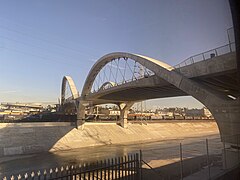6th Street Viaduct | |
|---|---|
 The second incarnation of the Sixth Street Viaduct, 2023 | |
| Coordinates | 34°2′17″N 118°13′37″W / 34.03806°N 118.22694°W |
| Carries | 6th Street/Whittier Boulevard |
| Crosses | Metrolink tracks, Los Angeles River, Union Pacific Railroad tracks, Santa Ana Freeway, Golden State Freeway, several local streets |
| Locale | Downtown and Boyle Heights areas of Los Angeles, California |
| Official name | Sixth Street Bridge from the LA River |
| Other name(s) | 6th Street Viaduct |
| Maintained by | City of Los Angeles and California Department of Transportation (Caltrans) |
| ID number | 53C-1880 (City of Los Angeles), 53-0595 (Caltrans) |
| Characteristics | |
| Design | Viaduct |
| Material | Reinforced concrete and steel |
| Total length | 3,500 feet (1,100 m) |
| Width | 46 feet (14 m) |
| History | |
| Opened | November 9, 1932[1] (Original viaduct) July 9, 2022 (Replacement viaduct) |
| Closed | January 27, 2016 (Original viaduct) |
| Location | |
 | |
The Sixth Street Viaduct, also known as the Sixth Street Bridge, is a viaduct bridge that connects the Arts District in Downtown Los Angeles with the Boyle Heights neighborhood.
The Sixth Street Viaduct spans the Los Angeles River, the Santa Ana Freeway (US 101), and the Golden State Freeway (I-5), as well as Metrolink (Orange County and 91/Perris Valley lines), Amtrak (Pacific Surfliner and Southwest Chief), and Union Pacific (along with Metrolink's Riverside Line) railroad tracks and several local streets. The first incarnation, which opened in 1932 and demolished in 2016, was replaced with the second incarnation in 2022.
The predecessor was composed of three independent structures: the reinforced concrete west segment, the central steel arch segment over the river, and the reinforced concrete east segment. In 1986, the Caltrans bridge survey found the Sixth Street Viaduct eligible for inclusion in the National Register of Historic Places.[2]
The demolition of the predecessor bridge was due to serious structural issues, including several large cracks, resulting from the high alkaline content of the concrete composition, due to architectural unsophistication. As a result, concerns over the structure's seismic instability outweighed its historical status, leading to its closure for demolition and replacement in January 2016. The new replacement bridge was completed six years later and opened on July 9, 2022.
- ^ Bernal, Victoria (July 7, 2022). "23 Eye-Opening Photos of the Original Sixth Street Viaduct in Construction". PBS SoCal. Retrieved 10 April 2024.
- ^ "History of the Sixth Street Viaduct". Retrieved 24 October 2015.